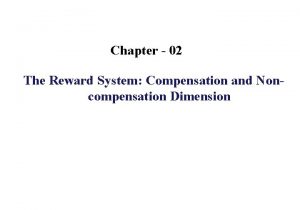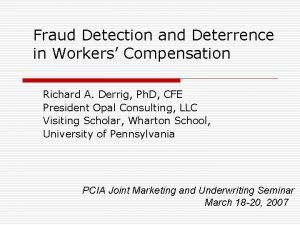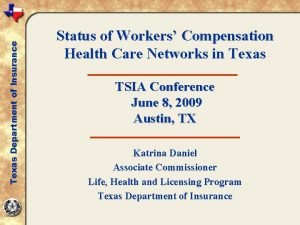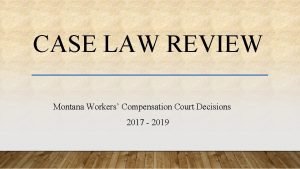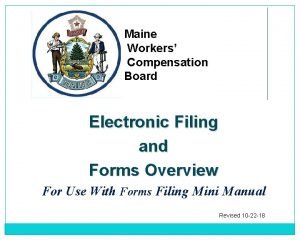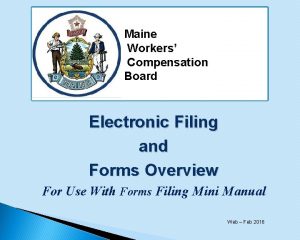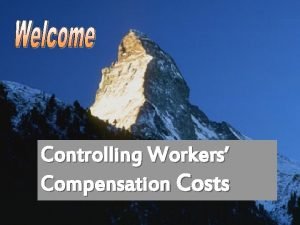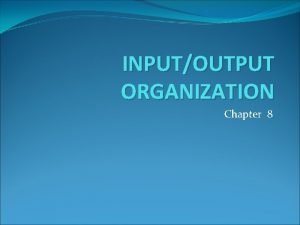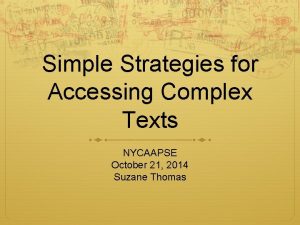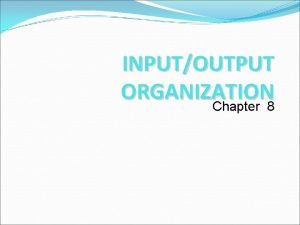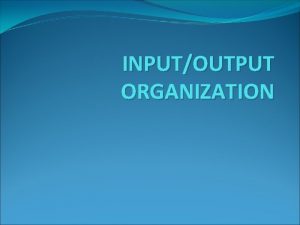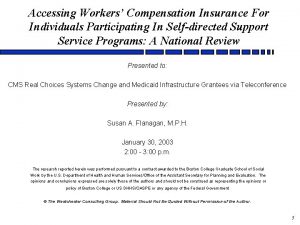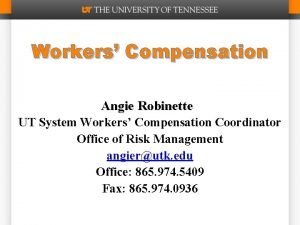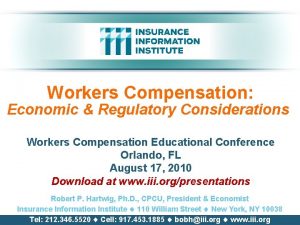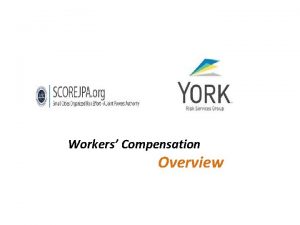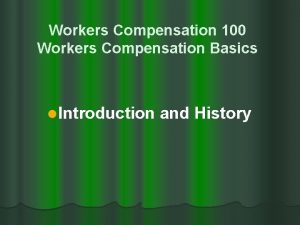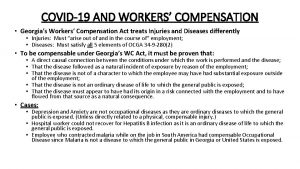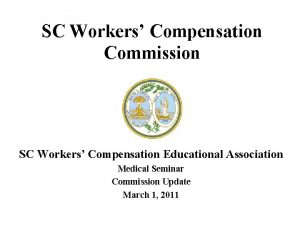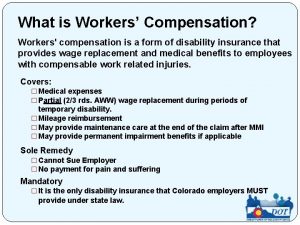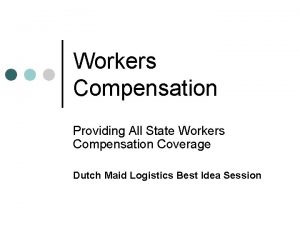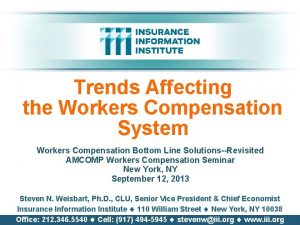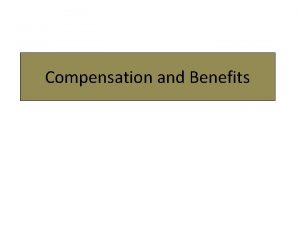Accessing Workers Compensation Insurance For ConsumerEmployed PAS Workers


























- Slides: 26

Accessing Workers’ Compensation Insurance For Consumer-Employed PAS Workers: Issues and Promising Practices Presented to: CMS Real Choices Systems Change Grantees Presented by: Susan A. Flanagan, M. P. H. The Westchester Consulting Group September 28, 2004 1: 30 - 3: 00 p. m. The research reported herein was performed pursuant to a contract awarded to the Boston College Graduate School of Social Work by the U. S. Department of Health and Human Services/Office of the Assistant Secretary for Planning and Evaluation. The opinions and conclusions expressed are solely those of the authors and should not be construed as representing the opinions or policy of Boston College or US DHHS/OASPE or any agency of the Federal Government. © The Westchester Consulting Group. Material Should Not Be Quoted Without Permission of the Author. 1

I. Overview n Individuals with disabilities of all ages have greater access to publicly-funded, self-directed home and community-based services and supports than ever before. n Some programs allow the individual or his/her representative to be the common law (household employer) of his/her personal assistance workers. n With choice and control comes employer responsibilities and the potential risk of liability. n One potential risk of liability is associated with a personal assistance worker being injured on the job. n One way public programs can reduce the potential risk of liability of workplace injury for themselves and service recipients who are household employers of domestic/personal assistance workers is by arranging and paying for workers’ compensation insurance. 2

II. n Study Scope and Methodology Scope of the Study l This study focused on workers’ compensation (WC) laws and systems as they pertain to domestic service workers, and in particular, personal assistance workers, in 50 states, the District of Columbia, five U. S. territories (American Samoa, Guam, the Commonwealth of Northern Mariana Islands, Puerto Rico, and the Virgin Islands) and the tribal government of the Navajo Nation. l Study questions included: 1. How do workers’ compensation insurance programs work? 2. What jurisdictions afford individuals with disabilities, who are household employers, the opportunity to purchase workers’ compensation insurance for their domestic service/PAS workers; 3. How accessible is WC insurance for household employers with disabilities who hire domestic service/PAS workers; 4. How does the cost of WC insurance vary for household employers who hire domestic service/PAS workers across jurisdictions and markets; 5. What issues and challenges have been raised by state agency and insurance company staff related to the administration of WC systems and the provision workers’ compensation to this employer group; and 6. What promising practices have been implemented by jurisdictions to facilitate public programs arranging for and paying for WC insurance for service recipients who hire domestic service/PAS workers? 3

II. n Study Scope and Methodology (continued) The research methods used in this study included: l A review of secondary information for 50 states, the District of Columbia, five U. S. territories and one tribal government including: - Workers’ compensation laws and regulations; - Workers’ compensation program and insurance carriers’ materials; and - Related literature, including published reports. l Follow-up calls to key workers’ compensation agency, insurance agent, and insurance company staff in each jurisdiction as needed to obtain information not readily available from the secondary information collected. 4

III. What is Workers’ Compensation? n Workers’ Compensation (WC) in the U. S. is a combined government and private insurance program mandated by state or territorial law, administered by one or more state or territorial agencies and paid for entirely by employers ( except OR and WA State that allow contributions from employees). n It is a no-fault social insurance system, similar to no-fault auto insurance, that mandates the payment of statutorily defined medical, disability and other benefits (e. g. , death and burial) to most workers whose injures and illnesses “arise out of and in the course of employment” (e. g. , “closely, ” “directly” or “distinctly” associated with employment) (Lencsis, 1998). n From a social policy perspective, it has been argued that the ultimate goal of WC should be to provide protection for all employees since the losses due to injury for a non-business (domestic) worker is no less serious than for an industrial worker (Larson, 2002). n Others argue that WC is a “business insurance” and the associated costs are “business expenses” that should be passed along to the customer in the price of the product. In the case of domestic service, the worker’s employment is not in the course of the trade, business, profession or occupation of his/her employer. As a result, the household employer must assume the full cost of insurance directly (Larson, 2002). 5

IV. What Are Workers’ Compensation Laws? n WC laws define the responsibilities of the employer to provide prompt medical, disability, and other benefits (e. g. , death and burial) for injuries sustained on the job by workers, resulting in partial or total incapacity or death. In return, the employer is shield from tort liability for those injuries. n All 50 states, the District of Columbia, the five U. S. territories and the territorial government of the Navajo Nation have WC laws. They are either compulsory or elective. n WC laws and systems are specific to each state and territory and can be complex. n A basic objective of WC insurance is that coverage under the laws be virtually, if not completely universal. However, for various historical, political, economic and/or administrative reasons, no state or territory’s law covers all forms of employment (U. S. Chamber of Commerce, 2002). 6

IV. What Are Workers’ Compensation Laws? (continued) n Two benefits for employers under WC law are: l l The remedies available (and the amount of the employer’s liability) under WC laws are generally limited to medical, disability, death and burial benefits. Disability, death and burial benefits are typically subject to ceilings limiting potential recovery. An employee’s right to WC is usually the exclusive remedy against the employer for accidental injuries and occupational diseases falling within the coverage formula of the WC law. The worker has no right to damages for pain and suffering or punitive damages in most states. n However, there are some limited situations where the worker may maintain a tort action (e. g. , when employer intentionally injures an employee or when an employer acts in a dual employer capacity with respect to an employee). n Employers who do not obtain WC insurance for their non-exempt (“covered”) workers are considered out of compliance with the law and may be subject to substantial penalties and the risk of tort liability. 7

IV. What Are Workers’ Compensation Laws? (continued) n Exempt (“non-covered”) employees represent a relatively small percent of total employees, but they are important, especially with regards to employers’ liability insurance. n Three employment classes often considered exempt from workers’ compensation laws are: l l l Persons whose work is casual and not in the course of the trade, business, profession or occupation of the employer; “Minor employers” (those with less than three, four or five workers); and Household/domestic service workers. 8

V. n Study Findings What Are the Workers’ Compensation Insurance Requirements for Domestic Service/Casual Employees? l l l Forty-nine states and five territories allow household employers to purchase WC insurance for their domestic service workers (WY and Navajo Nation do not allow coverage). Thirty-four states, the District of Columbia and one territory exempt “casual” employees and those whose employment is not in the trade, business, profession or occupation of the employer. Sixteen states, and one territory exempt employers with less than three, four or five workers. Twenty-five states and two territories exempt domestic service workers. Twenty-two states, the District of Columbia and two territories partially exempt domestic service workers. Two states (NH, NJ) and one territory (PR) require coverage for domestic service workers. 9

V. n l l l Study Findings (continued) How Are Domestic Service and Personal Assistance Service Workers Defined in Workers’ Compensation Laws and Employment Classification Codes? In general, domestic service and personal assistance services are not well defined in WC laws. Forty-five states, the District of Columbia and five territories do not define domestic service in the definition section of their workers’ compensation laws. Six states define domestic service in their WC laws (HI, MN, NV, NH and OR). Of the six, two do not include personal assistance in the definition of domestic service (NV and MI) and two include some reference to personal assistance (HI § 381 -1(6) references attendant care and day care services authorized by HI DHS under SSA Act and performed by individual employed by service recipient and OR ORS 656. 026(1) references home health workers). Two states specifically exclude personal assistance from the definition of domestic service. NH does not allow a person with a disability to consider their worker under domestic service. MN states that a person with a disability who receives public assistance can not be considered the employer of their worker. 10

V. Study Findings (continued) l l Approximately 40 states, the District of Columbia and Guam use the employment classification system developed by the National Council on Compensation Insurance (NCCI) and maintained in the National Scopes Manual. Domestic Worker-Inside classification codes (0908 and 0913) include broad terms (e. g. , companion and nurse) that may or may not describe personal assistance. They also do not specifically address the provision of occasional transportation. Some jurisdictions’ WC agency staff say it is included while others say that the employer should be bumped up to the outside domestic worker classification codes (0909 and 0912) to cover the risk. Classification codes often do not address activities such as assistance with medication administration and health maintenance activities. When a worker performs these tasks WC agency staff are tempted to reassign these workers under a home health classification code but householder is not considered a business. Some jurisdictions have developed their own domestic classification codes ( e. g. , CA, NV, NJ, ND, OH, OR, TX, WA and WV and Puerto Rico and Virgin Island). Some are included as “state-specific” in the National Scopes Manual while other are included in manuals specific to the jurisdiction. 11

V. Study Findings (continued) l l l n l One state (ND) and one territory (PR) specifically mention personal assistance in its employment classification code for domestic service. Oregon mentions “home health workers. ” Massachusetts is the only state to develop their own domestic service code for personal assistance. It is under the general domestic service classification (09) and includes occasional transportation, assistance ADLs, IADLs, health maintenance activities and with the administration of medications (Classification code 0918 Domestic Service Workers - Inside -Physical Assistance). The majority of jurisdictions reported that the final determination of whether a personal assistance worker is considered under domestic service is based on the results of a WC claims appeal. Under What Circumstances Are Family Members Considered ‘Covered’ Workers Under WC Laws? WC laws in 38 states, the District of Columbia and four territories are silent regarding the status of family members as covered employees. Usually in these cases a family member must be a paid employee to be considered covered. Although not in law, Guam’s policy is family members who are hired as a domestic worker and live in the employer’s home are not covered under WC. 12

V. Study Findings (continued) l n Twelve states have specific provisions in law that address exemptions for certain types of family members (CA, CT, HI, ID, IA, KS, ME, MI, MO, ND, OK, and VT). In some cases, an employer may elect WC coverage for the workers either through a standard policy (e. g. , HI, ID, and OK) or an optional policy (e. g. , ND) while in other cases (e. g. , CA and MI) election is not an option. Accessing WC Insurance Voluntary Market l l Forty-five states, the District of Columbia and three territories have a voluntary WC insurance market and the number of carriers authorized to write policies in most jurisdictions is significant. However, overall access to the voluntary WC insurance market for household employers is low. Five states (AR, FL, NH, NM, NC) reported access to be “nonexistent” for household employers. 13

V. Study Findings (continued) l l The primary reason given for the low access was agents and insurance companies have little or no incentive to write WC policies for household employers due to small administrative fees (for agents), small premiums (for insurers), significant administrative burden (for agents and insurers) and perceived high risk exposure (for insurers). However, Massachusetts uses an agent and a voluntary carrier with good results. - MA claims experience (2001 -2002) for 6, 938 household employers was low ($2, 389, 620 in audited premiums paid, 68 claims filed, and $489, 900 losses paid for a total payroll of $119, 385, 197). Government Insurance Funds l l Currently, five states (ND, OH, WA, WV, and WY) and two territories (PR and VI) have exclusive government (state) insurance funds. - Household employers appeared to have the best success accessing WC insurance from exclusive state insurance funds (with the exception of WY). Nine states have competitive state insurance funds (AZ, CA, ID, MT, NY, OR, PA and UT). 14

V. Study Findings (continued) - Household employers had moderate success accessing WC from competitive state insurance funds since they have to compete in the voluntary market (High access in Pennsylvania). - Two reported their mission was to serve small and moderate sized businesses (e. g. , AZ, OR), one had a program specifically for domestic service workers (PADomestic Service Exemption Policy) and at least one reported they were hesitant to write policies for household employers (OR). Residual Market l l l Access to WC insurance for household employers was moderate or better in jurisdictions’ residual markets because in general they must take all comers. However, the premiums were the highest. Two potential barriers to the residual market were the need to get refusals from the voluntary market (declination letters) and the use of an agent. Forty-five states and the District of Columbia have some type of residual market. Twenty-nine states and the District of Columbia have Assigned Risk Plans, of which 20 are administered by NCCI. 15

V. Study Findings (continued) l l Twenty-one states have “insurers/markets of last resort” and nine were competitive state insurance funds. Five states (AZ, ID, MN, NM, and OR) have both an Assigned Risk Plan and an “insurer/market of last resort. ” These provided potentially the best access to household employers. Homeowner’s and Tenant’s Insurance l l l Some jurisdictions afford household employers the option of purchasing WC insurance coverage for their domestic service workers through endorsements to their homeowner’s (and in some cases tenant’s) insurance policies. Nineteen states, the District of Columbia and two territories reported that household employers had the option of purchasing WC insurance for their domestic workers through a homeowner’s policy (AZ, CA, CO, CT, DC, HI, ID, IL, IN, IA, LA, MS, MT, NV, NH, NJ, NY, ND, SD, VA, AS, NMI) if coverage is not already available through a standard WC policy. At least three states, (CA, NH, and NJ) they mandate the availability of WC through homeowners insurance in statute. 16

V. Study Findings (continued) l l NCCI reported that it had filed a WC endorsement for residence employees (WC 00 03 12 (Ed. 4 -84)) in 39 states and the District of Columbia, but of those, 31 states (79. 5%) reported either that the endorsement was not being used or staff could not confirm its existence. NJ law mandates that all homeowner’s and tenant’s policies include an endorsement for domestic service workers (occasional) with the option of covering full-time domestic service workers including personal assistance workers through both the voluntary and residual markets. Theoretically, covering WC for domestic service workers through homeowner’s and tenant’s insurance makes sense. However, it may be risky for homeowners to cover their workers for WC this way. If the homeowner files a WC claim in the current environment, there is a risk that the insurer may cancel his/her homeowner’s insurance policy which may be required for this/her mortgage. Having a separate WC policy may be less risky. 17

V. Study Findings (continued) Alternative WC Plans l l l Alabama, Georgia and Louisiana reported that employers, including household employers, have the option of purchasing an Alternative Workers’ Compensation Plan for their workers. An Alternative Workers’ Compensation Plan may consist of any combination of life, disability, accident, health or other insurance provided that the coverage insures without limitation or exclusion any of the WC benefits as defined in the State’s WC law. Sometimes coverage is written together with the employer liability policies issued by affiliated or non-affiliated liability insurers. In the absence of an affiliation, the insurer would normally be a joint venturer, or be involved in a “strategic alliance” or similar group enterprise with a life insurer. 18

V. n Study Findings (continued) Affordability of Workers’ Compensation Insurance (Minimum Premiums Reported for either CY 2002 or 2003) Voluntary Insurance Market l l l It was not possible to assess the affordability of WC insurance premiums in the voluntary market due to competitive pricing. However, they should be the most affordable option in a jurisdiction if a household employer can find an insurer to write the policy. Minimum premiums were assessed for administered pricing states. Minimum premiums for 0908 Domestic Worker - Occasional, ranged from a low of $16. 00/year/household policy (actual premium in NJ) to a high of $427 per capita per year (FL). Minimum premiums for 0913 Domestic Worker - (Full-time) ranged from a low of $76/year per household policy (actual premium in New Jersey for one full-time worker) to a high of $750 per capita per year in Florida. 19

V. Study Findings (continued) Government Insurance Funds l l l Minimum premiums for government insurance funds were at least moderately affordable and tended to use the per $100 payroll and per household policy methods. Minimum premiums for classification code 0908 ranged from a low of $130. 88/year/household policy (NY) to a high of $400 per capita per year (UT). Minimum premiums for classification code 0913 ranged from a low of $175 per household per year (MD) to a high of $505 per capita per year (PA). 20

V. Study Findings (continued) Residual Insurance Market l l l In general, minimum premiums for the residual market were the most expensive and the least affordable for household employers. They tended to use the per capita method for determining rates and policies. Minimum premiums for classification code 0908 ranged from a low of $130. 88 per household policy per year (NY) to a high of $664 per capita per year (FL). Minimum premiums for classification code 0913 range from a low of $175 per household per year (MD) to a high of $1, 542 per capita per year (FL). Homeowners/Tenants Insurance Market l l New Jersey reported an endorsement premium of $1. 00/policy/year for occasional workers and $61/policy/year for a full-time worker. New Hampshire reported an endorsement premium of $3. 00/policy/year. 21

V. n Study Findings (continued) Issues and Challenges Raised by WC Agency and Agent and Insurance Company Staff l Classification of personal assistance workers under domestic service was not always clear. Final determination of personal assistance worker status is based on the results of a WC claims appeal. This presents significant uncertainty and risk for household employers. l l Access to the voluntary insurance market for household employers is low and the cost of premiums in the residual market are significant. Requiring the use of agents and obtaining refusals from voluntary insurance carriers can represent barriers to accessing WC insurance for household employers. WC premiums for household employers under domestic service tend to be “low” and may not cover losses incurred in all cases according to insurers. One state insurance fund staff person questioned whether occasional users of domestic service should be allowed to avoid tort liability at a cost that is unfairly low and costly to the state WC system. WC claims for CD-PAS in two states (MA and NJ) were very low contrary to conventional wisdom. However, a representative of the Maine Mutual Insurance Co. reported significant losses related to domestic service workers. 22

V. Study Findings (continued) l l l Three states (KS, NY and RI) reported that they had not seen a lot of WC policies and claims for domestic service. So it is hard to determine risks and compute accurates. Three States (MO, WA and WI) reported that WC insurance premiums had gone up significantly for all employers including household employers in the recent past. There may be a minimum number of household employers that are needed to provide a voluntary carrier with the financial incentive to write policies for individual household employers. One estimate provided was 3, 600 policies that reflect approximately $1. 3 million in premiums. Fiscal/Employer Agents can reduce the burden for insurance carriers and facilitate the purchase of WC insurance for household employers. Making sure that employers have the proper coverage is a challenge in the territories. MN and NH restrict employers with disabilities from accessing workers compensation insurance under the domestic service classification - This is a potential ADA issue. 23

VI. n Promising Practices Conclusion and Promising Practices l One way public programs can reduced the risk of liability of workplace injury for themselves and service recipients who are household employers of domestic/personal assistance workers is by arranging and paying for workers’ compensation insurance. l l Clearly Defining Domestic Service in the WC Law and Including Personal Assistance in the Definition - Promising Practice States and Territories - Hawaii Developing Employer Classification Codes for Domestic Service That Include Personal Assistance Workers - Promising Practice States and Territories - Massachusetts and North Dakota Allowing Household Employers to Elect WC Coverage for Their Domestic/Personal Assistance Service Workers - Promising Practice States and Territories - All jurisdictions but Wyoming Allowing Household Employers to Access WC Insurance for Domestic/Personal Assistance Workers Through Homeowners’ and Tenants’ Insurance - Promising Practice States and Territories - New Jersey 24

VI. Promising Practices (continued) l l l Accessing WC Insurance Through the Voluntary Insurance Market - Promising Practice States and Territories - Massachusetts Accessing WC Insurance Through the Residual Insurance Market Via Both an Insurer/Market of Last Resort and Assigned Risk Plan - Promising Practice States and Territories - Arizona and New Mexico Developing WC Insurance Program Specifically for Household Employers/Domestic Service Workers - Promising Practice States and Territories - Pennsylvania Using Effective Rate and Premium Setting Methods - Promising Practice States and Territories - Massachusetts (per $100/payroll and per household policy) and Washington State (per hour and per household policy). Using Fiscal Employer Agents to Facilitate the Purchase of WC Insurance and Process (Wages Statements, Monitoring Workers’ Work Status and Invoicing) - Promising Practice States and Territories - Massachusetts, New Jersey and Pennsylvania 25

VI. Promising Practices (continued) l l l Developing a Small Business Ombudsman to Facilitate Access to WC Insurance - Promising Practice States and Territories - Oregon Using minimum premium date to develop benchmarks for WC premiums - Promising Practice States and Territories - NJ, ID, and MD Allowing household employers to elect WC insurance coverage for family members who are paid domestic service/PAS workers - Promising Practice States and Territories - Hawaii 26
 Ubiór tadeusza soplicy
Ubiór tadeusza soplicy Noncompensation
Noncompensation Workers compensation fraud detection
Workers compensation fraud detection Texas hcn workers compensation
Texas hcn workers compensation Liberty mutual insurance
Liberty mutual insurance Oregon workers compensation division
Oregon workers compensation division Work comp puncture
Work comp puncture Maine workers compensation forms
Maine workers compensation forms Maine workers compensation forms
Maine workers compensation forms Controlling workers compensation costs
Controlling workers compensation costs Texte lecture pas à pas
Texte lecture pas à pas Moteur pas à pas à aimant permanent
Moteur pas à pas à aimant permanent On ne peut pas ne pas communiquer
On ne peut pas ne pas communiquer Ne pleure pas devant ma tombe mary elizabeth frye
Ne pleure pas devant ma tombe mary elizabeth frye Functions of fire insurance
Functions of fire insurance Dawnlodaimg and accessing
Dawnlodaimg and accessing Accessing mainframe data from java
Accessing mainframe data from java Accessing input output devices
Accessing input output devices Flipping bits in memory without accessing them
Flipping bits in memory without accessing them Nycaapse
Nycaapse Accessing i/o devices
Accessing i/o devices Mutable and immutable files in distributed system
Mutable and immutable files in distributed system Accessing io devices
Accessing io devices Claes martinsson
Claes martinsson Ledarskapsteorier
Ledarskapsteorier Plats för toran ark
Plats för toran ark Plagg i rom
Plagg i rom

